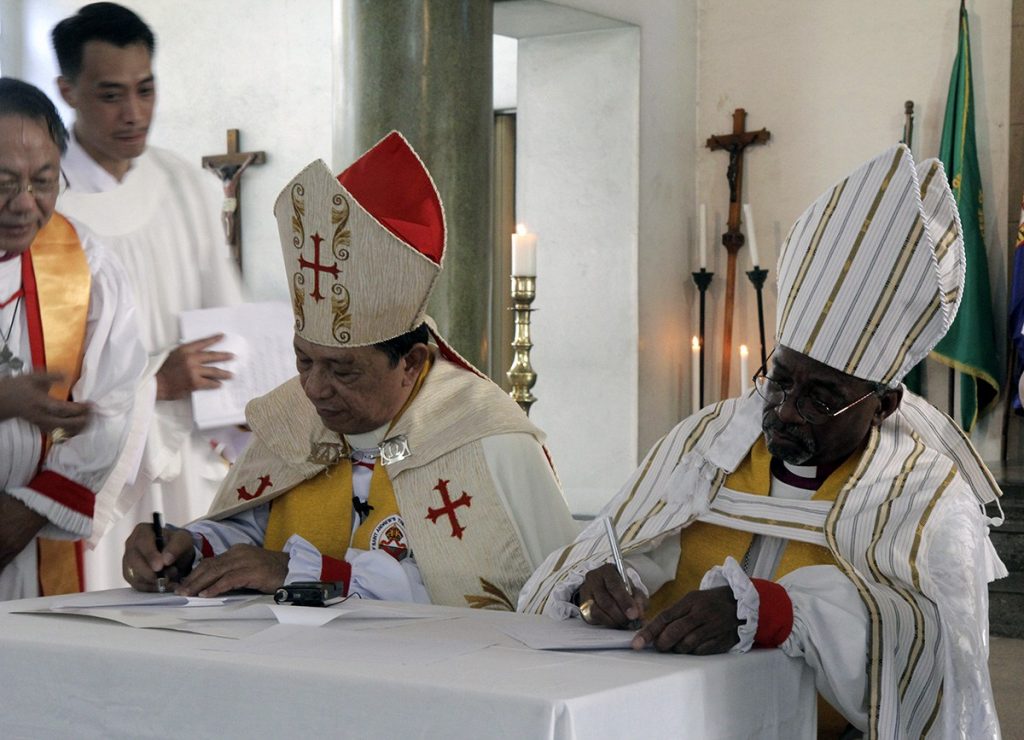The Episcopal News Service covered a historic signing of a concordat agreement between Presiding Bishop Michael Curry and Prime Bishop Renato Abibico, during Bishop Curry’s visit to Asia and southeast Asia:
The bishops signed the concordat, based in friendship, cooperation and mutual respect, during a Feb. 18 Eucharist at the Cathedral of St. Mary and St. John in Quezon City, a part of metro Manila. Clergy traveled in some cases more than 12 hours to witness the historic document’s signing. Curry made the Philippines his first of four stops on a tour of Asia and Southeast Asia that included Hong Kong, China and Taiwan.
The ENS story looks at the history behind what is termed a “companion agreement”:
The Episcopal Church established a missionary district in the Philippines in 1901, when the United States controlled the archipelago. In 1965, the church became a missionary diocese; and in 1990 the Episcopal Church of the Philippines became an autonomous province of the Anglican Communion. At the time of autonomy, the two churches established a covenant relationship, whereby the U.S.-based church continued to provide the Philippine church with 60 percent of its operating budget.
During a visit to the Philippine church’s national headquarters in a brand-new building on its 37-acre compound in Quezon City, which also includes Trinity University of Asia and St. Andrew’s Theological Seminary, the presiding bishop and his staff heard a presentation by Floyd Lalwet, the Philippine church’s provincial secretary, about its story from financial dependence to self-sufficiency.
Two years after becoming an independent province the Joint Committee on the Philippine Covenant in 1992 proposed a 15-year plan to gradually reduce the support from the Episcopal Church from $800,000 to $533,333 to $267,667 over five-year intervals.
In 2004, a year after the Philippine church ran its highest-ever budget deficit, its leadership, by then worried for the church’s survival, contemplated asking the Episcopal Church for a three-year extension. After heated debate, however, the church reversed course and decided rather than prolong its dependence, it would become independent on Jan. 1, 2005, two years before the agreement expired, explained Lalwet.
“It took the leadership to change its thinking,” he said, adding that in 2005, after implementing the church ended the year with a $60,000 surplus.
The Philippine Church has become an independent, self-sustaining church in many ways, with plans to build a new hospital and seminary, and its own prayer book:
…during the church’s centennial celebration, it introduced its version of the Book of Common Prayer, which was revised in 2014 and is now in the process of being translated into four languages.
Increasingly the church reflects the “culture of the people,” said [the Rev. Thomas Maddela, registrar and liturgics professor at the current seminary, St. Andrew’s] Maddela, in an interview with ENS outside the cathedral.
Read the entire story here.
Image from ENS site. Caption: Episcopal Church of the Philippines Prime Bishop Renato Abibico and Episcopal Church Presiding Bishop Michael Curry signed the concordat agreement on Feb. 18 during a Eucharist at the Cathedral of St. Mary and St. John in Quezon City. Photo: Lynette Wilson/Episcopal News Service

